MAPK8
| MAPK8 | |||||||||||||||||||||||||||||||||||||||||||||||||||
|---|---|---|---|---|---|---|---|---|---|---|---|---|---|---|---|---|---|---|---|---|---|---|---|---|---|---|---|---|---|---|---|---|---|---|---|---|---|---|---|---|---|---|---|---|---|---|---|---|---|---|---|
 | |||||||||||||||||||||||||||||||||||||||||||||||||||
| |||||||||||||||||||||||||||||||||||||||||||||||||||
| Identifiers | |||||||||||||||||||||||||||||||||||||||||||||||||||
| Aliases | MAPK8, Mapk8, AI849689, JNK, JNK1, Prkm8, SAPK1, JNK-46, JNK1A2, JNK21B1/2, SAPK1c, mitogen-activated protein kinase 8 | ||||||||||||||||||||||||||||||||||||||||||||||||||
| External IDs | OMIM: 601158; MGI: 1346861; HomoloGene: 56760; GeneCards: MAPK8; OMA:MAPK8 - orthologs | ||||||||||||||||||||||||||||||||||||||||||||||||||
| |||||||||||||||||||||||||||||||||||||||||||||||||||
| |||||||||||||||||||||||||||||||||||||||||||||||||||
| |||||||||||||||||||||||||||||||||||||||||||||||||||
| |||||||||||||||||||||||||||||||||||||||||||||||||||
| |||||||||||||||||||||||||||||||||||||||||||||||||||
| Wikidata | |||||||||||||||||||||||||||||||||||||||||||||||||||
| |||||||||||||||||||||||||||||||||||||||||||||||||||
Mitogen-activated protein kinase 8 (also known as JNK1) is a ubiquitous enzyme that in humans is encoded by the MAPK8 gene.[5][6]
Function
The protein encoded by this gene is a member of the MAP kinase and JNK family. MAP kinases act as an integration point for multiple biochemical signals, and are involved in a wide variety of cellular processes such as proliferation, differentiation, transcription regulation and development. This kinase is activated by various cell stimuli, and targets specific transcription factors, and thus mediates immediate-early gene expression in response to cell stimuli. The activation of this kinase by tumor-necrosis factor alpha (TNF-alpha) is found to be required for TNF-alpha-induced apoptosis. This kinase is also involved in UV radiation-induced apoptosis, which is thought to be related to the cytochrome c-mediated cell death pathway. Studies of the mouse counterpart of this gene suggested that this kinase play a key role in T cell proliferation, apoptosis and differentiation. Four alternately spliced transcript variants encoding distinct isoforms have been reported.[7] MAPK8 contains multiple amino acid sites that are phosphorylated and ubiquitinated.[8]
Interactions
MAPK8 has been shown to interact with:
- Activating transcription factor 2,[9][10][11][12]
- C-jun,[5][12][13][14][15][16][17][18]
- CRK,[19]
- DUSP10,[20]
- DUSP1,[21]
- GSTP1,[22]
- IRS1,[23][24]
- ITCH, [25][26]
- MAP2K4,[11][12][27][28][29]
- MAP2K7,[12][27]
- MAP3K1[30]
- MAP3K2,[27]
- MAPK8IP1,[31][32]
- MAPK8IP3,[33][34]
- Myc,[35]
- REL,[13]
- SH3BP5,[36] and
- SPIB.[37]
References
- ^ a b c GRCh38: Ensembl release 89: ENSG00000107643 – Ensembl, May 2017
- ^ a b c GRCm38: Ensembl release 89: ENSMUSG00000021936 – Ensembl, May 2017
- ^ "Human PubMed Reference:". National Center for Biotechnology Information, U.S. National Library of Medicine.
- ^ "Mouse PubMed Reference:". National Center for Biotechnology Information, U.S. National Library of Medicine.
- ^ a b Dérijard B, Hibi M, Wu IH, Barrett T, Su B, Deng T, Karin M, Davis RJ (April 1994). "JNK1: a protein kinase stimulated by UV light and Ha-Ras that binds and phosphorylates the c-Jun activation domain". Cell. 76 (6): 1025–37. doi:10.1016/0092-8674(94)90380-8. PMID 8137421. S2CID 6797795.
- ^ Gupta S, Barrett T, Whitmarsh AJ, Cavanagh J, Sluss HK, Dérijard B, Davis RJ (July 1996). "Selective interaction of JNK protein kinase isoforms with transcription factors". EMBO J. 15 (11): 2760–70. doi:10.1002/j.1460-2075.1996.tb00636.x. PMC 450211. PMID 8654373.
- ^ "Entrez Gene: MAPK8 mitogen-activated protein kinase 8".
- ^ "JNK1 (human)". www.phosphosite.org. Retrieved 2020-10-28.
- ^ Raingeaud J, Gupta S, Rogers JS, Dickens M, Han J, Ulevitch RJ, Davis RJ (March 1995). "Pro-inflammatory cytokines and environmental stress cause p38 mitogen-activated protein kinase activation by dual phosphorylation on tyrosine and threonine". J. Biol. Chem. 270 (13): 7420–6. doi:10.1074/jbc.270.13.7420. PMID 7535770.
- ^ Fuchs SY, Xie B, Adler V, Fried VA, Davis RJ, Ronai Z (December 1997). "c-Jun NH2-terminal kinases target the ubiquitination of their associated transcription factors". J. Biol. Chem. 272 (51): 32163–8. doi:10.1074/jbc.272.51.32163. PMID 9405416.
- ^ a b Chen Z, Cobb MH (May 2001). "Regulation of stress-responsive mitogen-activated protein (MAP) kinase pathways by TAO2". J. Biol. Chem. 276 (19): 16070–5. doi:10.1074/jbc.M100681200. PMID 11279118.
- ^ a b c d Tournier C, Whitmarsh AJ, Cavanagh J, Barrett T, Davis RJ (July 1997). "Mitogen-activated protein kinase kinase 7 is an activator of the c-Jun NH2-terminal kinase". Proc. Natl. Acad. Sci. U.S.A. 94 (14): 7337–42. Bibcode:1997PNAS...94.7337T. doi:10.1073/pnas.94.14.7337. PMC 23822. PMID 9207092.
- ^ a b Meyer CF, Wang X, Chang C, Templeton D, Tan TH (April 1996). "Interaction between c-Rel and the mitogen-activated protein kinase kinase kinase 1 signaling cascade in mediating kappaB enhancer activation". J. Biol. Chem. 271 (15): 8971–6. doi:10.1074/jbc.271.15.8971. PMID 8621542.
- ^ Ishitani T, Takaesu G, Ninomiya-Tsuji J, Shibuya H, Gaynor RB, Matsumoto K (December 2003). "Role of the TAB2-related protein TAB3 in IL-1 and TNF signaling". EMBO J. 22 (23): 6277–88. doi:10.1093/emboj/cdg605. PMC 291846. PMID 14633987.
- ^ Nishitoh H, Saitoh M, Mochida Y, Takeda K, Nakano H, Rothe M, Miyazono K, Ichijo H (September 1998). "ASK1 is essential for JNK/SAPK activation by TRAF2". Mol. Cell. 2 (3): 389–95. doi:10.1016/s1097-2765(00)80283-x. PMID 9774977.
- ^ Yazgan O, Pfarr CM (August 2002). "Regulation of two JunD isoforms by Jun N-terminal kinases". J. Biol. Chem. 277 (33): 29710–8. doi:10.1074/jbc.M204552200. PMID 12052834.
- ^ Tada K, Okazaki T, Sakon S, Kobarai T, Kurosawa K, Yamaoka S, Hashimoto H, Mak TW, Yagita H, Okumura K, Yeh WC, Nakano H (September 2001). "Critical roles of TRAF2 and TRAF5 in tumor necrosis factor-induced NF-kappa B activation and protection from cell death". J. Biol. Chem. 276 (39): 36530–4. doi:10.1074/jbc.M104837200. PMID 11479302.
- ^ Cano E, Hazzalin CA, Kardalinou E, Buckle RS, Mahadevan LC (November 1995). "Neither ERK nor JNK/SAPK MAP kinase subtypes are essential for histone H3/HMG-14 phosphorylation or c-fos and c-jun induction". J. Cell Sci. 108 (11): 3599–609. doi:10.1242/jcs.108.11.3599. PMID 8586671.
- ^ Girardin SE, Yaniv M (July 2001). "A direct interaction between JNK1 and CrkII is critical for Rac1-induced JNK activation". EMBO J. 20 (13): 3437–46. doi:10.1093/emboj/20.13.3437. PMC 125507. PMID 11432831.
- ^ Tanoue T, Moriguchi T, Nishida E (July 1999). "Molecular cloning and characterization of a novel dual specificity phosphatase, MKP-5". J. Biol. Chem. 274 (28): 19949–56. doi:10.1074/jbc.274.28.19949. PMID 10391943.
- ^ Slack DN, Seternes OM, Gabrielsen M, Keyse SM (May 2001). "Distinct binding determinants for ERK2/p38alpha and JNK map kinases mediate catalytic activation and substrate selectivity of map kinase phosphatase-1". J. Biol. Chem. 276 (19): 16491–500. doi:10.1074/jbc.M010966200. PMID 11278799.
- ^ Wang T, Arifoglu P, Ronai Z, Tew KD (June 2001). "Glutathione S-transferase P1-1 (GSTP1-1) inhibits c-Jun N-terminal kinase (JNK1) signaling through interaction with the C terminus". J. Biol. Chem. 276 (24): 20999–1003. doi:10.1074/jbc.M101355200. PMID 11279197.
- ^ Aguirre V, Werner ED, Giraud J, Lee YH, Shoelson SE, White MF (January 2002). "Phosphorylation of Ser307 in insulin receptor substrate-1 blocks interactions with the insulin receptor and inhibits insulin action". J. Biol. Chem. 277 (2): 1531–7. doi:10.1074/jbc.M101521200. PMID 11606564.
- ^ Aguirre V, Uchida T, Yenush L, Davis R, White MF (March 2000). "The c-Jun NH(2)-terminal kinase promotes insulin resistance during association with insulin receptor substrate-1 and phosphorylation of Ser(307)". J. Biol. Chem. 275 (12): 9047–54. doi:10.1074/jbc.275.12.9047. PMID 10722755.
- ^ Gao M, Labuda T, Xia Y, Gallagher E, Fang D, Liu YC, Karin M (October 2004). "Jun turnover is controlled through JNK-dependent phosphorylation of the E3 ligase Itch". Science. 306 (5694): 271–5. Bibcode:2004Sci...306..271G. doi:10.1126/science.1099414. PMID 15358865. S2CID 31876966.
- ^ Gallagher E, Gao M, Liu YC, Karin M (February 2006). "Activation of the E3 ubiquitin ligase Itch through a phosphorylation-induced conformational change". Proceedings of the National Academy of Sciences of the United States of America. 103 (6): 1717–22. Bibcode:2006PNAS..103.1717G. doi:10.1073/pnas.0510664103. PMC 1413664. PMID 16446428.
- ^ a b c Cheng J, Yang J, Xia Y, Karin M, Su B (April 2000). "Synergistic interaction of MEK kinase 2, c-Jun N-terminal kinase (JNK) kinase 2, and JNK1 results in efficient and specific JNK1 activation". Mol. Cell. Biol. 20 (7): 2334–42. doi:10.1128/mcb.20.7.2334-2342.2000. PMC 85399. PMID 10713157.
- ^ Lee CM, Onésime D, Reddy CD, Dhanasekaran N, Reddy EP (October 2002). "JLP: A scaffolding protein that tethers JNK/p38MAPK signaling modules and transcription factors". Proc. Natl. Acad. Sci. U.S.A. 99 (22): 14189–94. Bibcode:2002PNAS...9914189L. doi:10.1073/pnas.232310199. PMC 137859. PMID 12391307.
- ^ Park HS, Kim MS, Huh SH, Park J, Chung J, Kang SS, Choi EJ (January 2002). "Akt (protein kinase B) negatively regulates SEK1 by means of protein phosphorylation". J. Biol. Chem. 277 (4): 2573–8. doi:10.1074/jbc.M110299200. PMID 11707464.
- ^ Xu S, Cobb MH (December 1997). "MEKK1 binds directly to the c-Jun N-terminal kinases/stress-activated protein kinases". J. Biol. Chem. 272 (51): 32056–60. doi:10.1074/jbc.272.51.32056. PMID 9405400.
- ^ Elion EA (September 1998). "Routing MAP kinase cascades". Science. 281 (5383): 1625–6. doi:10.1126/science.281.5383.1625. PMID 9767029. S2CID 28868990.
- ^ Cai Y, Lechner MS, Nihalani D, Prindle MJ, Holzman LB, Dressler GR (January 2002). "Phosphorylation of Pax2 by the c-Jun N-terminal kinase and enhanced Pax2-dependent transcription activation". J. Biol. Chem. 277 (2): 1217–22. doi:10.1074/jbc.M109663200. PMID 11700324.
- ^ Ito M, Yoshioka K, Akechi M, Yamashita S, Takamatsu N, Sugiyama K, Hibi M, Nakabeppu Y, Shiba T, Yamamoto KI (November 1999). "JSAP1, a novel jun N-terminal protein kinase (JNK)-binding protein that functions as a Scaffold factor in the JNK signaling pathway". Mol. Cell. Biol. 19 (11): 7539–48. doi:10.1128/mcb.19.11.7539. PMC 84763. PMID 10523642.
- ^ Kelkar N, Gupta S, Dickens M, Davis RJ (February 2000). "Interaction of a mitogen-activated protein kinase signaling module with the neuronal protein JIP3". Mol. Cell. Biol. 20 (3): 1030–43. doi:10.1128/mcb.20.3.1030-1043.2000. PMC 85220. PMID 10629060.
- ^ Noguchi K, Kitanaka C, Yamana H, Kokubu A, Mochizuki T, Kuchino Y (November 1999). "Regulation of c-Myc through phosphorylation at Ser-62 and Ser-71 by c-Jun N-terminal kinase". J. Biol. Chem. 274 (46): 32580–7. doi:10.1074/jbc.274.46.32580. PMID 10551811.
- ^ Wiltshire C, Matsushita M, Tsukada S, Gillespie DA, May GH (November 2002). "A new c-Jun N-terminal kinase (JNK)-interacting protein, Sab (SH3BP5), associates with mitochondria". Biochem. J. 367 (Pt 3): 577–85. doi:10.1042/BJ20020553. PMC 1222945. PMID 12167088.
- ^ Mao C, Ray-Gallet D, Tavitian A, Moreau-Gachelin F (February 1996). "Differential phosphorylations of Spi-B and Spi-1 transcription factors". Oncogene. 12 (4): 863–73. PMID 8632909.
Further reading
- Lin, A (2006). "The JNK Signaling Pathway (Molecular Biology Intelligence Unit)". Landes Bioscience. 1: 1–97. ISBN 978-1587061202.
- Davis RJ (2000). "Signal transduction by the JNK group of MAP kinases". Cell. 103 (2): 239–52. doi:10.1016/S0092-8674(00)00116-1. PMID 11057897. S2CID 343677.
- Liu J, Lin A (2007). "Wiring the cell signaling circuitry by the NF-kappa B and JNK1 crosstalk and its applications in human diseases". Oncogene. 26 (22): 3267–78. doi:10.1038/sj.onc.1210417. PMID 17496921. S2CID 28428831.
External links
- MAP Kinase Resource Archived 2021-04-15 at the Wayback Machine.
This article incorporates text from the United States National Library of Medicine, which is in the public domain.
- v
- t
- e
-
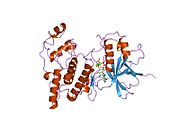 1jnk: THE C-JUN N-TERMINAL KINASE (JNK3S) COMPLEXED WITH MGAMP-PNP
1jnk: THE C-JUN N-TERMINAL KINASE (JNK3S) COMPLEXED WITH MGAMP-PNP -
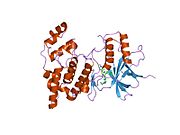 1pmn: Crystal structure of JNK3 in complex with an imidazole-pyrimidine inhibitor
1pmn: Crystal structure of JNK3 in complex with an imidazole-pyrimidine inhibitor -
 1pmq: The structure of JNK3 in complex with an imidazole-pyrimidine inhibitor
1pmq: The structure of JNK3 in complex with an imidazole-pyrimidine inhibitor -
 1pmu: The crystal structure of JNK3 in complex with a phenantroline inhibitor
1pmu: The crystal structure of JNK3 in complex with a phenantroline inhibitor -
 1pmv: The structure of JNK3 in complex with a dihydroanthrapyrazole inhibitor
1pmv: The structure of JNK3 in complex with a dihydroanthrapyrazole inhibitor -
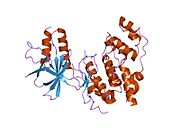 1ukh: Structural basis for the selective inhibition of JNK1 by the scaffolding protein JIP1 and SP600125
1ukh: Structural basis for the selective inhibition of JNK1 by the scaffolding protein JIP1 and SP600125 -
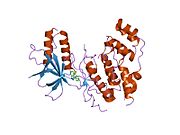 1uki: Structural basis for the selective inhibition of JNK1 by the scaffolding protein JIP1 and SP600125
1uki: Structural basis for the selective inhibition of JNK1 by the scaffolding protein JIP1 and SP600125 -
 2b1p: inhibitor complex of JNK3
2b1p: inhibitor complex of JNK3 -
 2exc: Inhibitor complex of JNK3
2exc: Inhibitor complex of JNK3 -
 2g01: Pyrazoloquinolones as Novel, Selective JNK1 inhibitors
2g01: Pyrazoloquinolones as Novel, Selective JNK1 inhibitors -
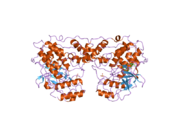 2gmx: Selective Aminopyridine-Based C-Jun N-terminal Kinase inhibitors with cellular activity
2gmx: Selective Aminopyridine-Based C-Jun N-terminal Kinase inhibitors with cellular activity -
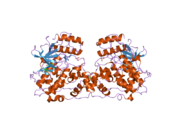 2h96: Discovery of Potent, Highly Selective, and Orally Bioavailable Pyridine Carboxamide C-jun NH2-terminal Kinase Inhibitors
2h96: Discovery of Potent, Highly Selective, and Orally Bioavailable Pyridine Carboxamide C-jun NH2-terminal Kinase Inhibitors -
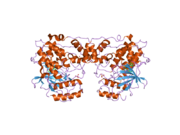 2no3: Novel 4-anilinopyrimidines as potent JNK1 Inhibitors
2no3: Novel 4-anilinopyrimidines as potent JNK1 Inhibitors -
![2o0u: Crystal structure of human JNK3 complexed with N-{3-cyano-6-[3-(1-piperidinyl)propanoyl]-4,5,6,7-tetrahydrothieno[2,3-c]pyridin-2-yl}-1-naphthalenecarboxamide](//upload.wikimedia.org/wikipedia/commons/thumb/f/f1/PDB_2o0u_EBI.jpg/180px-PDB_2o0u_EBI.jpg) 2o0u: Crystal structure of human JNK3 complexed with N-{3-cyano-6-[3-(1-piperidinyl)propanoyl]-4,5,6,7-tetrahydrothieno[2,3-c]pyridin-2-yl}-1-naphthalenecarboxamide
2o0u: Crystal structure of human JNK3 complexed with N-{3-cyano-6-[3-(1-piperidinyl)propanoyl]-4,5,6,7-tetrahydrothieno[2,3-c]pyridin-2-yl}-1-naphthalenecarboxamide -
 2o2u: Crystal structure of human JNK3 complexed with N-(3-cyano-4,5,6,7-tetrahydro-1-benzothien-2-yl)-2-fluorobenzamide
2o2u: Crystal structure of human JNK3 complexed with N-(3-cyano-4,5,6,7-tetrahydro-1-benzothien-2-yl)-2-fluorobenzamide -
 2ok1: Crystal structure of JNK3 bound to N-benzyl-4-(4-(3-chlorophenyl)-1H-pyrazol-3-yl)-1H-pyrrole-2-carboxamide
2ok1: Crystal structure of JNK3 bound to N-benzyl-4-(4-(3-chlorophenyl)-1H-pyrazol-3-yl)-1H-pyrrole-2-carboxamide






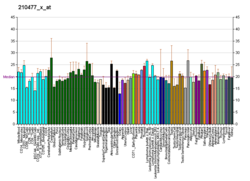














![2o0u: Crystal structure of human JNK3 complexed with N-{3-cyano-6-[3-(1-piperidinyl)propanoyl]-4,5,6,7-tetrahydrothieno[2,3-c]pyridin-2-yl}-1-naphthalenecarboxamide](http://upload.wikimedia.org/wikipedia/commons/thumb/f/f1/PDB_2o0u_EBI.jpg/180px-PDB_2o0u_EBI.jpg)












